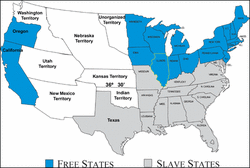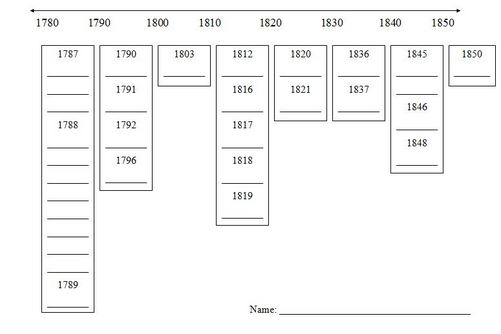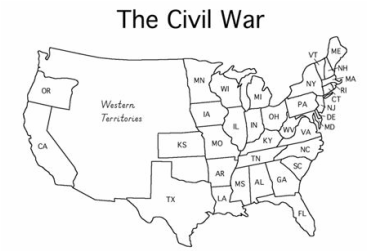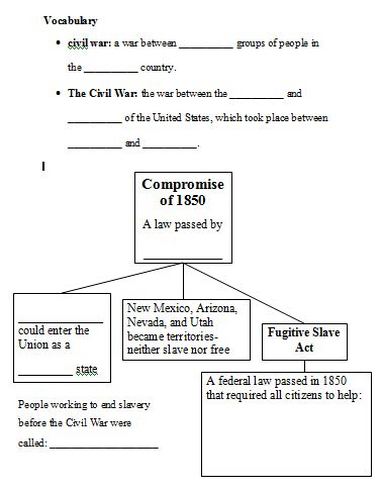Lesson 1: A Nation Divided

Lesson Essential Questions:
How did slavery divide the North and the South in the mid 1800s?
How did the United States government deal with the issue of slavery?
How did slavery divide the North and the South in the mid 1800s?
How did the United States government deal with the issue of slavery?
NCSS Standards:
MMSD Standards:
2. Use map and globe reading skills
3. Identify key events, causes, and effects of a major period in U.S. history
UW Teaching Standards:
Materials Needed:
Objectives:
Lesson Context:
This is the first lesson in the unit, Wisconsin and the Civil War. It is meant to serve as an introductory lesson that provides students with background knowledge needed before exploring deeper issues such as slavery and how the civil war affected Wisconsin and the United States. Students must first understand some of the issues that divided the people of the United States during the 1800s.
Lesson Opening:
First I will explain to students that we are starting a unit about The Civil War, a war that was fought in the United States in the 1800s. Today we’re going to be talking about what the United States was like before the Civil War. First, let’s just talk about everything we already know about the Civil War. Shout out your ideas, and I’ll write it all down on this web.
Procedures:
Closing:
Today we discussed how the United States was divided on the issue of slavery. We also learned how the government’s attempts to find a compromise lead to a further division of the nation. Next, we will be exploring the issue of slavery more in-depth to learn how it affected many lives.
Assessment:
I will informally assess students on their participation in small and whole group discussions.
I will formally assess students by looking to see that they have accurately completed their maps, time-lines, and definitions.
Special Considerations:
There are a few ELLs in my class, so I will stop periodically throughout the reading to discuss vocabulary words and allow the class to repeat challenging words aloud
The map will be pre-labeled with state names and the time-line will be pre-labeled with dates to help students follow along
- Standard 2: Time, Continuity, and Change
- Standard 6: Power, Authority, and Governance
- Standard 10: Civic Ideals and Practices
MMSD Standards:
- Students will:
2. Use map and globe reading skills
3. Identify key events, causes, and effects of a major period in U.S. history
UW Teaching Standards:
- Standard 10: employs varied instructional strategies
- Standard 11: Uses technology
Materials Needed:
- Book: Malone, B. & Oberle, K. (2008). Wisconsin: Our State, Our History. Wisconsin Historical Society Press.
- United State Maps and time-lines
- Color pencils or markers
- Document camera and projector screen
- Graphic organizers
Objectives:
- Students will examine the order that states formed prior to the Civil War by: creating a time-line of the formation of states into the union and coloring in free and slave states
- Students will use their map to discuss how slavery divided the nation in the 1800s
- Students will be able to explain the role the government had in further dividing the US over the issue of slavery
Lesson Context:
This is the first lesson in the unit, Wisconsin and the Civil War. It is meant to serve as an introductory lesson that provides students with background knowledge needed before exploring deeper issues such as slavery and how the civil war affected Wisconsin and the United States. Students must first understand some of the issues that divided the people of the United States during the 1800s.
Lesson Opening:
First I will explain to students that we are starting a unit about The Civil War, a war that was fought in the United States in the 1800s. Today we’re going to be talking about what the United States was like before the Civil War. First, let’s just talk about everything we already know about the Civil War. Shout out your ideas, and I’ll write it all down on this web.
Procedures:
- I will hand out the maps to students and conduct a brief discussion:
- This is a map of what the United States looked like in 1850. What do you notice about the map?
- We are going to create a timeline and map showing when each state entered the union- or the United States. We are also going to discuss slavery, because we will find out that some states were for slavery and some were against it.
- Explain to students that Union is another way of saying the United States
- I will read off the states and the year that they entered the Union and the students will record the state on their time-line. I will also fill one in using the document camera so that they can follow along.
- Next I will tell them to color in the state either gray or blue depending on if it was a slave or free state.
- After we have completed the time-line and map, I will ask students again to describe what they notice.
- Turn to the person next to you and discuss what you notice on the map
- Can someone share with the whole group what you and your partner discussed?
- Why do you think the Free states and the Slave states were divided the way they were?
- What kind of problems do you think this caused?
- Do you think everyone in the North and everyone in the South had the same opinion about slavery?
- After our brief discussion, the students will take out their social studies books and turn to page 124.
- As we read page 124, we will stop to discuss any unknown vocabulary words (such as: labor, cultivate)
- Students will write down the definition of civil war and the Civil War on their handout: - civil war: a war between two groups of people in the same country. - The Civil War: the war between the North and
South of the United States, which took place between 1861 and 1865
- We will discuss that many countries have civil wars for various reasons. The civil war in the United States occurred due to slavery as well as other political reasons. When we refer to the civil war in the US we capitalize the letters: Civil War
- Next we will read page 125. During and after the reading, we will define some key terms using a graphic organizer.
- Parts of the Compromise of 1850
- Definition of Fugitive Slave Act
- Definition of abolish and abolitionists
- After completing their graphic organizer, we will discuss the effects the Compromise of 1850 had on the US.
- Who do you think agreed with the Compromise of 1850 and the Fugitive Slave Act? Who disagreed with it?
- What roles do slaves have in government decisions?
- How do you think this affected slaves, slave owners, and non slave owners?
- What risks do you think abolitionists faced?
- How else do you think Congress could have addressed the issue of slavery?
Closing:
Today we discussed how the United States was divided on the issue of slavery. We also learned how the government’s attempts to find a compromise lead to a further division of the nation. Next, we will be exploring the issue of slavery more in-depth to learn how it affected many lives.
Assessment:
I will informally assess students on their participation in small and whole group discussions.
I will formally assess students by looking to see that they have accurately completed their maps, time-lines, and definitions.
Special Considerations:
There are a few ELLs in my class, so I will stop periodically throughout the reading to discuss vocabulary words and allow the class to repeat challenging words aloud
The map will be pre-labeled with state names and the time-line will be pre-labeled with dates to help students follow along
Time-line

Students will write in the abbreviation of each state under the year it became a state and then color the state on their map.
Map

Every student will have a copy of this map. They will color slave states gray and free states blue. They will discuss what they notice, as well as refer back to this map throughout the rest of the unit.
Vocab Graphic Organizer

Students will use this worksheet to guide their reading. They will fill in the missing words from the definitions and complete the graphic organizer about the three parts of the Compromise of 1850.
